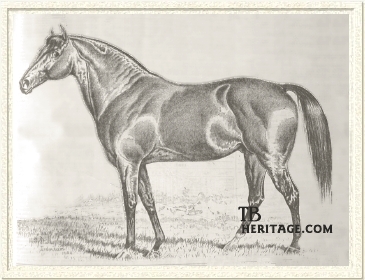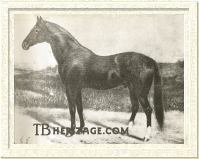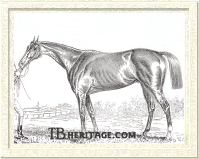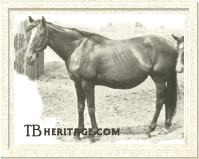|
|
Alarm

|
|
 |
|
|
Alarm is considered to be the first great American sprinter, introducing a new era of speed in American racing. Described as "invincible at a mile or less," he passed on his brilliance to successive generations; his grandson Domino being the quintessence of American speed. Alarm's male line once dominated racing in this country and survives through his champion son Himyar, and through Himyar's sons Plaudit and Domino, to the present day.
Alarm was bred in New York by John Hunter at Annieswood Stud in Westchester County, in the vicinity of Francis Morris's Throg's Neck Stud, where his sire, *Eclipse, was in residence. *Eclipse (b.c. 1855 by Orlando - Gaze by Bay Middleton) was typical of many of the progeny of Touchstone's elegant and prosperous son, Orlando, in that he was not quite up to the classic distances in England. At two, *Eclipse won the Clearwell Stakes, but was unplaced in the Champagne Stakes. At three, he was highly regarded, with the high point of his career being a dead-heat in that spring's Newmarket Stakes (ten furlongs) with stablemate Beadsman. *Eclipse also won the Hampton Court Sales Stakes (ten furlongs, Newmarket), Ascot Biennial Stakes (eight furlongs, Ascot), and was third in the Stockbridge Derby, but was fourth in the Derby Stakes (behind Beadsman, in a large field), and also unplaced in the St. Leger and Cambridgeshire Handicap.
In mid-season (1858), *Eclipse was sold to the American Richard Ten Broeck, whose British stable also included such American-bred cracks as Prioress (the first American-bred stakes winner in England), Starke, Umpire, and Lecomte. In September at the Newmarket Houghton meeting, a match was arranged against Beadsman, but the latter's owner paid the forfeit and the race never went off. *Eclipse remained in England in 1859 but did not race, and at the end of the year, he and the good racemare *Barbarity (who became one of his most famous mates), were imported and installed at Francis Morris's Throg's Neck Stud.
Here he stood his premier U.S. season, but the next year was moved to Major Barak Thomas's Dixiana Stud in Kentucky, where he made the 1861 and 1862 seasons. It was in 1862 that Francis Morris, having foals from the stallion's first crop, purchased *Eclipse outright, although the horse stood at least one season in New Jersey before returning to Throg's Neck Stud, where he died in 1878, at the age of 23.
Although cursed with a savage temperament, *Eclipse's first crop to race included several runners with exceptional speed that quickly drew attention to the young stallion. He was frequently among the nation's leading sires, and was second twice (behind Lexington) and twice third. The Eclipse Course at old Morris Park was named in his honor. Besides his best son, Alarm, *Eclipse is also remembered as the sire of Francis Morris's "Barbarous Batallion," five top class full sisters out of his shipmate, the mare *Barbarity: Ruthless (Belmont Stakes), Merciless (Alabama Stakes), Regardless (Alabama Stakes), Remorseless, and Relentless, every one at or near the top of her sex and age.
*Eclipse also sired the undefeated stayer Narragansett, Scathelock, Catesby (sire of the classy gelding Crickmore), Fannie Ludlow, Nemesis, and Midday. His daughters became excellent broodmares. Nemesis produced Rhadamanthus, Eachus, and Retribution (dam of Requital). As a foundation mare for August Belmont, Lady Blessington produced Count d'Orsay, The Countess, Lady Rosebery, and Duchess (dam of Clifford). Mayflower produced the California sire Joe Hooker. Other top producing daughters were Felicity (dam of champion Faithless), Megara (dam of champion Spinaway), Mimi (dam of Kinglike), as well as Ecliptic and Electra.

*Eclipse's best son was Alarm, whose dam was also imported, and was herself an accomplished producer. *Maud (1859) was by the great sire Stockwell, whose daughters were much sought after as broodmares by American breeders. *Maud's other offspring included Attraction (among August Belmont's broodmares), and Maudina (dam of Preakness and Belmont Stakes winner Cloverbrook.
Alarm raced for Annieswood Stable, a partnership between John Hunter, William R. Travers, and George Osgood, which had much success both with runners and breeding stock. His career spanned the period that noted the shift from four-mile heat racing to dash racing. At two, he started four times, winning twice. His debut came with a victory in a $5,000 match race with Inverary, at Saratoga over a mile on August 16. The next day, he was beaten by Sue Ryder and Joe Daniels in the Kentucky Stakes at the same distance. The first week in October at the Jerome Park meet, he was second in the Nursery Stakes (one mile) to Joe Daniels on a heavy track, beating the remainder of a nice field. Three days later, Inverary exacted his revenge when defeating him in the Desert Stakes (Jerome Park, one mile).
At three, Alarm was undefeated in five starts from six to ten furlongs. His most impressive win was when defeating Fadladeen and Kingfisher over a mile at Saratoga in 1:42 3/4, a new American record time. Building up to that season finale, he won a "club purse" at Jerome Park on June 1 at six furlong, and five days later scored another club purse going a mile and a quarter. A week after, he won at a club purse at a mile, then reverted back to sprinting six furlongs at Saratoga in July, as a prep for his record mile. He was then retired from racing with seven wins in nine starts.
The quality of his speed, although remarkable, was as yet unappreciated, and he was judged "only a moderate racehorse judged by his trials with Buckden (who conceded 20 pounds and beat him six lengths.)" His brilliance was wrapped up in a "robust" 15.3 hand package broad and strong, with a thick neck, excellent feet and legs, and soundness. He also had a kind and willing nature, obviously a tribute to his dam, by the phlegmatic Stockwell, and not inherited from the difficult *Eclipse. His jockey noted "He was the easiest horse I ever rode." Alarm was a bright bay with a small star, with his right hind and left front feet white.
Alarm entered stud in 1874, initially at James Grinstead's Walnut Hills Farm, south of Lexington, Kentucky. Following the success of his great son Himyar, Alarm was sold in 1878 to Aristides Welch. Alarm stood that season at Dixiana Farm in Kentucky and later in the year was moved to Pennsylvania to replace *Leamington, the premier stallion at Erdenheim Stud near Chestnut Hill, Pennsylvania, who had died that May. When Welch sold the farm to Commodore Kittson in May of 1882, Alarm and most of the bloodstock came as part of the package.
In early 1888, Kittson dissolved his stud at Erdenheim, and George Long purchased Alarm, along with the stallion's son Pardee, and broodmare daughters Luminous and Albia, to help establish his Bashford Manor Stud outside of Louisville, Kentucky. Alarm died here in 1895 and was buried on the farm. The property has long since fallen to development in the Louisville urban sprawl, and his grave has been undoubtedly paved or built over and lost to time.
Alarm's most notable offspring came from his first crop, the brilliant HIMYAR (lt.b.c. 1875 out of Hira by Lexington). Bred by Maj. Thomas (who handled his grandsire *Eclipse), at Dixiana, Himyar came equipped with a highly strung temperament, but also a tremendous hindquarter that propelled him to the forefront of his crop at two in "the West" (meaning the Midwest).
|

Himyar
| |
That year, he won the Colt Stakes at Lexington, the Colt and Filly Stakes also at Lexington, the Belle Meade Stakes at Louisville, and was third in the Colt and Filly Sweepstakes in his debut. At three, he won the Phoenix Hotel Stakes (14 furlongs), Belle Meade Stakes (12 furlongs), and January Stakes (in mile heats), and was second in the Kentucky Derby to Day Star, and in the Elkhorn Stakes to Cammie F.. Getting a late start (September) to the season at four, he was undefeated in four starts, including a victory over Day Star. At five, Himyar won the Merchants' Stakes (9f.) and Turf Stakes. At six he was fourth in his only start in September, to cap off his career with 14 wins in 27 starts.
|
|
At stud Himyar proved exceptional, particularly during his early years at stud in Kentucky (he was sold to Tennessee in 1897 and died there in 1905). His most famous son was the brilliant sprinter Domino, also bred by Thomas, whose feats at two made Himyar the Leading Sire in 1893. Although short-lived, Domino became one of the most important influences in breeding at the first part of the 20th Century in America. Himyar also sired Domino's older sister, the champion handicap mare Correction, foaled in 1888, and for whom the race at Aqueduct is named. Correction was the dam of Futurity winner Yankee and granddam of Haste. Himyar's other important son was the 1898 Kentucky Derby winner Plaudit, whose sire line continued through his son King James to Questionnaire, Rough'n Tumble, and ultimately to Holy Bull in the present day. Himyar also sired Hyphen, Halton Georgia, and Harry Reed.
|

Panique
| |
After Himyar, Alarm's most important offspring was 1884 Belmont Stakes winner PANIQUE (ch.c. 1881 out of Maggie B.B. by *Australian). Bred by Aristides Welch at Erdenheim Stud, he was a younger half-brother Epsom Derby winner Iroquois and champion two-year-old and Preakness winner Harold, all out of Maggie B. B., Welch's blue hen. Winning the Saratoga Stakes at two, at three Panique won the prestigious Withers Stakes and Belmont Stakes, at the time the American equivalents of the 2,000 Guineas and Derby Stakes. (The Lawrence Realization Stakes was meant to be the U.S. St. Leger equivalent.) Unfortunately Panique was unsound and sired little of note.
|
Panique's sister RED AND BLUE (1880 out of Maggie B.B. by *Australian) was undistinguished on the track for the Dwyer Brothers, but traded to Runnymede Farm along with her sister Francesca, and the stallion prospect Hindoo, in exchange for the filly Miss Woodford, she proved an important broodmare. To the cover of Hindoo, Red and Blue produced the champion Sallie McClelland (Alabama and Spinaway Stakes; granddam of champion and sire Whisk Broom II) and the good broodmare Bonnie Blue II (dam of champion Blue Girl, among others).
Panique's lesser brother WAWEKUS (ch.c. 1883 out of Maggie B.B. by *Australian) became a sire of some importance in the pedigrees of early Quarter Horses. His daughter Katie Wawekus produced a colt, John Wilkens, sire of the great Quarter Horse runner and sire Joe Hancock.
Alarm's son PARDEE (ch. c. 1882 out of Sister of Mercy by War Dance) was a stakes winner bred by Erdenheim Stud, with a big score when in a dead-heat for first in the 1885 Tidal Stakes with Joe Cotton. Retired to stud at Erdenheim, he was sold along with Alarm, Luminous, and Albia to George Long to establish his Bashford Manor Stud in Kentucky. His only foal of importance is the colt Proteinol, whose daughter Bess Chitman was the dam of Dennis Reed (by Lobos), influential in early Quarter Horse breeding as the sire of Oklahoma Star.
|

Breeze
| |
Other good stakes winners by Alarm were BREEZE (b.f. 1880 out of *Blairgowrie by Breadalbane), who won the Champagne Stakes at two for owner Pierre Lorillard; and the aptly named SIS HIMYAR (f. 1883 out of Hira by Lexington), a full sister to Himyar. He also sired DANGER (c. 1875) bred by James Grinstead of Walnut Hills, where Alarm stood that first season, GABRIEL, PARTHENIA, and BRUNO.
|
Alarm's daughters were also successful broodmares and besides RED AND BLUE, included ALBIA (f. 1881 out of Elastic by Kentucky) dam of Kentucky Derby winner Azra, and the filly Roseville, later dam of champion and Leading Sire Ben Brush.
ANN FIEF (1876 out of Kate Walker by Embry's Lexington) produced the brilliant, undefeated champion juvenile Tremont, PLAYTHING (1875 out of The Pet by Vandal), was dam of champion Tournament. THE NIECE (f. 1882 out of Jaconet by *Leamington) produced the stakes winner and sire Uncle. The sisters PETTICOAT (1883 out of Lady Scarborough by *Leamington) and FIDELE (1882) became respectively the dam of Kentucky Derby winner Elwood and the important broodmare Forever. Another pair of sisters were ESPANITA (1890 out of Outstep by Blue Eyes; dam of Kentucky Derby winner Manuel), and ESPANOLA (1892; dam of Boema).
Other good daughters included MESSMATE (1879 out of Full Cry by Vandal; dam of Kentucky Oaks winner Selika), LUMINOUS (1883 out of Lady Lumley; dam of Alabama Stakes winner Ignite, herself dam of Kentucky Derby winner Sir Huon), MARY LETCHER (1889 out of Macaroona; dam of Oneck Queen, so ancestress to another great speed horse in Dr. Fager), and ALTITUDE (1883 out of Beresina; dam of Altamax).
After his death in 1895, Alarm's male line flourished through his son Himyar, diverging there into two male lines that survive to this day: Domino down the decades to Broad Brush; and Plaudit down the years to Holy Bull. Alarm's speed completely redefined the American Thoroughbred and American racing, and as we've seen, his influence in the Quarter Horse breed is also a lasting one.
--Anne Peters
|
|
|
|

